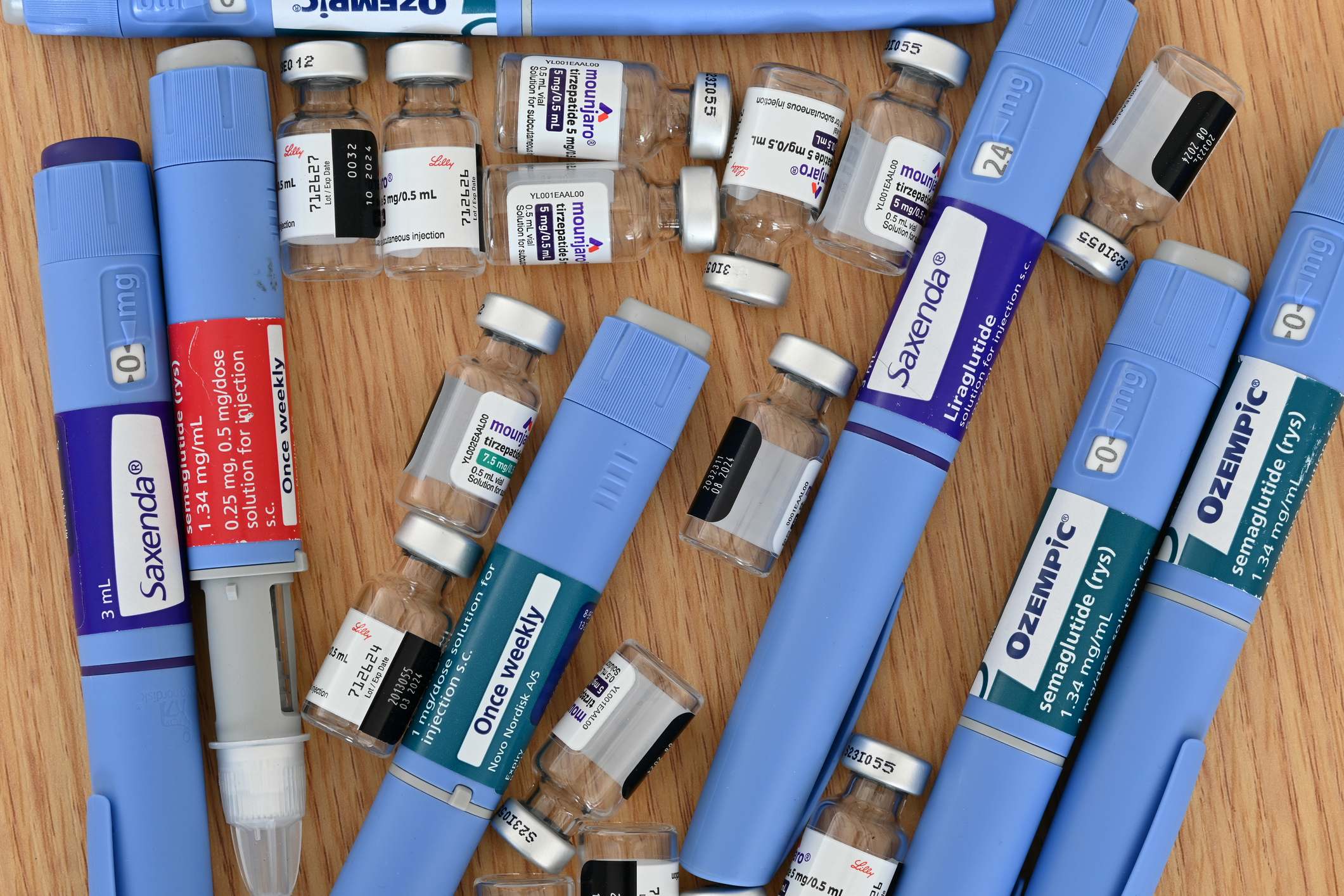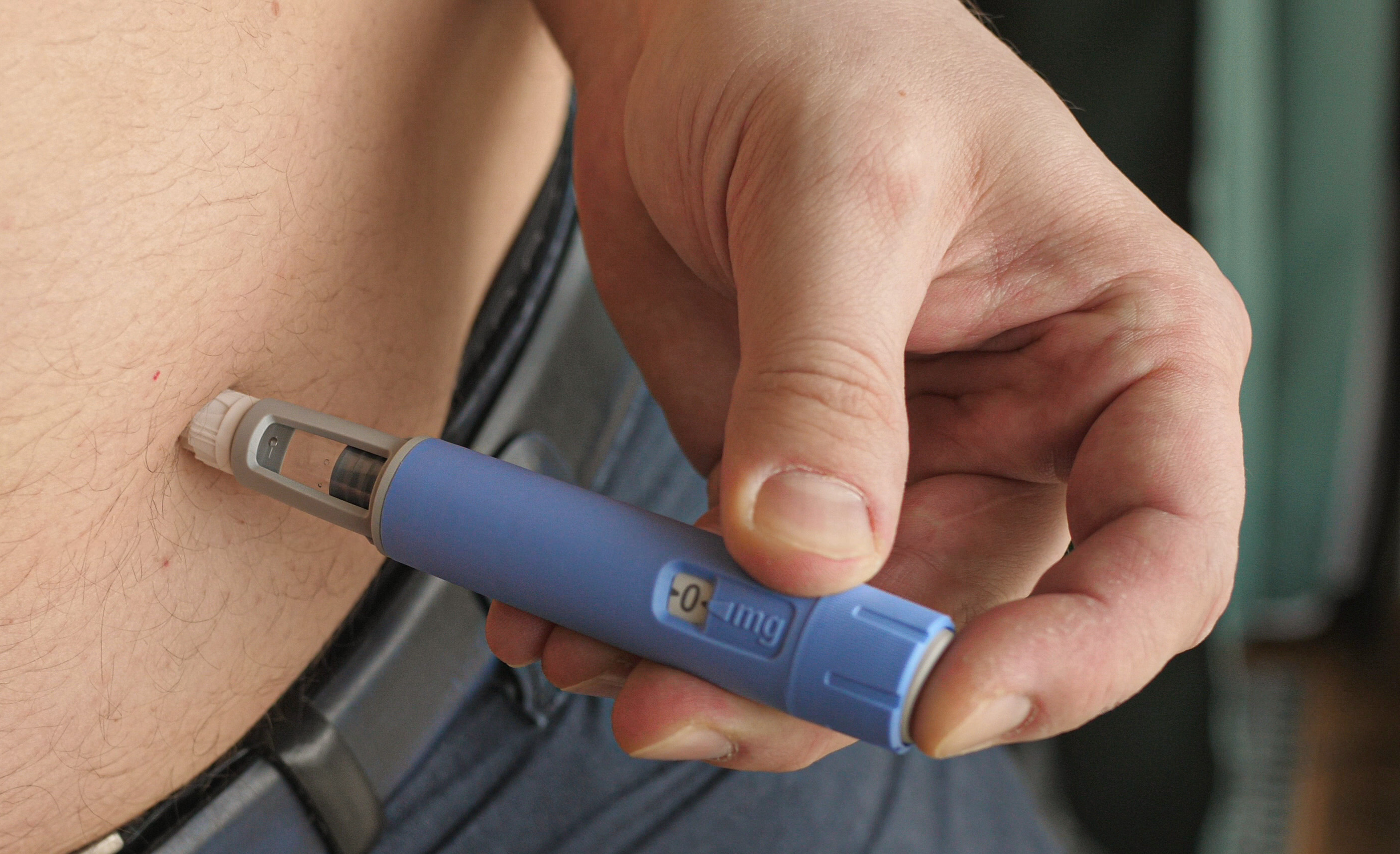Why Diabetes Miracle Drugs like Ozempic Are Off-Limits to Type 1s

Key takeaways:
- Adjunctive therapies like GLP-1 receptor agonists and SGLT-2 inhibitors can have major benefits for people with type 1 diabetes: flattening glucose levels, increasing time in range, and reducing the risk of heart and kidney disease.
- Concerns about risks, especially diabetic ketoacidosis, and lack of data have prevented these medications from gaining approval in type 1 diabetes.
- Several studies are underway to test adjunctive therapies in type 1 diabetes and may help move the needle towards approvals.
Editor’s Note: diaTribe does not provide medical advice or endorse the use of off-label medications like GLP-1 receptor agonists and SGLT-2 inhibitors for type 1 diabetes. Consult with your healthcare provider if you are curious about these medications.
Imagine if there were a drug for type 1 diabetes that could improve insulin sensitivity and blood sugar, while also providing weight loss and protecting against the development of heart disease and kidney disease. A miracle drug, if you will.
In fact, several such drugs exist. Their names might be familiar from TV commercials: Ozempic, Mounjaro, Jardiance, and Farxiga. These medications can be quite costly even with insurance coverage, and some have serious side effects. However, they are all FDA-approved specifically for people with type 2 diabetes.
To the frustration of many, these medications haven’t yet been approved by the FDA for use in type 1 diabetes because there haven’t been enough studies to demonstrate that the benefits outweigh the risks.

A few drugs were briefly approved in Europe, but were ultimately withdrawn due to safety concerns and commercial reasons. These setbacks were just the beginning.
While medications such as GLP-1 receptor agonists (Ozempic, Wegovy) and SGLT-2 inhibitors (Jardiance, Farxiga) demonstrated powerful benefits, they quickly were determined to pose too much of a liability for pharmaceutical companies or regulators due to concerns about safety. Specifically, GLP-1s can increase the risk of hypoglycemia (low blood sugar) and SGLT-2s can raise the risk of a serious, life-threatening complication called diabetic ketoacidosis (DKA).
Some people with type 1 diabetes choose to take these medications “off-label” with the support of their healthcare provider. This means taking a drug for a different purpose, at a different dose, or in a different dosage form from which it is FDA-approved.
Dr. Sanjoy Dutta, chief scientific officer at Breakthrough T1D“If people living with type 1 diabetes can avoid kidney failure or a heart attack, why should we deprive them of these medications?”
Prescribing off-label medications is legal, and even common in some cases. The Department of Health and Human Services estimates one in five prescriptions are for off-label use. But since the medication has not specifically been tested for that purpose, taking a medication off-label comes with risks. There could be unknown harms, or benefits. Ultimately, the decision comes down to whether safety and effectiveness for a specific patient outweighs the risks.

For Rebecca Jervey, a software trainer in Philadelphia, taking adjunctive medications has dramatically improved her diabetes management.
“I was diagnosed with type 1 diabetes 25 years ago, when diabetes medications were very basic,” Jervey said. “And we've been fighting for better therapies ever since then.”
Now, she credits the combination of metformin, Ozempic (semaglutide), and Farxiga (dapagliflozin) to flattening out her glucose levels, cutting her insulin dose in half, and helping her lose nearly 100 pounds. But most importantly, Jervey said, Ozempic has restored her relationship with food.
“I spent the first 25 years of diabetes having this empty pit in my stomach and nothing would fill it,” Jervey said, adding: “Ozempic has given back that feeling of fullness and I now have a healthy relationship with food again.”
Beyond the remarkable weight loss and the potential to reduce insulin doses, experts highlighted that these medications also protect people with type 1 diabetes from kidney and heart disease.
“If people living with type 1 diabetes can avoid kidney failure or a heart attack, why should we deprive them of these medications?” said Dr. Sanjoy Dutta, chief scientific officer at Breakthrough T1D (formerly JDRF).
What are adjunctive therapies?
Adjunctive therapies, which can be defined as medications that are used together with insulin in type 1 diabetes to manage glucose levels, are a hot topic in clinical research and at medical conferences. Yet there is currently only one FDA-approved adjunctive therapy for type 1: Symlin (pramlintide), a drug that is rarely used due to its long list of side effects.

“The word ‘adjunctive’ is about helping,” said Prof. Chantal Mathieu, professor of medicine at Katholieke Universiteit Leuven in Belgium and president of the European Association for the Study of Diabetes (EASD). “So adjunctive therapies are supposed to be therapies that help insulin with glucose-lowering.”
The history of adjunctive therapies in type 1 diabetes began with metformin, an oral medication approved in the U.S. in the 1990s that was given to some people with type 1 who had overweight or obesity to improve insulin sensitivity. It made insulin work better by reducing the amount of glucose released from the liver and helping cells to absorb more glucose from the blood.
While large clinical trials in type 1 diabetes showed that metformin had little effect on A1C and body weight, other research has shown that the same group does benefit from metformin, particularly for addressing insulin resistance.
Today, adjunctive therapies for type 1 diabetes that are not yet FDA approved include the glucose-lowering GLP-1s and SGLT-2s. Other medications like Kerendia (finerenone) that do not lower glucose are sometimes included as adjunctive therapies, too.
For Mathieu, how the diabetes community – which includes patient advocates, clinicians, diabetes educators, and industry leaders – talks about these medications could help healthcare providers recognize that the benefits may outweigh the risks for some people with type 1 diabetes. For instance, the data from large clinical trials in type 2 diabetes show that GLP-1s and SGLT-2s not only lower glucose but also protect the heart and kidneys.
“These medications are organ-protecting agents,’” Mathieu said. “Should we continue to call this adjunctive? Or just therapies that also affect glucose control and insulin needs and have some side effects typical or more frequent in type 1 diabetes?”
Benefits of adjunctive therapies
The benefits of GLP-1s, SGLT-2s, and metformin for type 1 diabetes are widely documented, both in clinical research and in anecdotes from people with diabetes. From flattening CGM curves to reducing “food noise” – the constant internal chatter that some people experience about food – adjunctive therapies can dramatically improve daily diabetes management. In the longer term, these medications can also prevent complications like kidney disease and heart failure for type 1s.
Incretin therapies like GLP-1s were created as glucose-lowering medications specifically to help people with diabetes. The tremendous weight loss was an unexpected benefit. In a cruel twist of fate, a substantial proportion of people with diabetes cannot even access these miracle drugs.
Improved blood sugar and insulin sensitivity
For Ginger Vieira, author of the book “Exercise with Type 1 Diabetes,” several changes in her mid-30s led her to consider taking diabetes medications off-label.
Vieira had been experiencing insulin resistance and stubborn weight gain, despite her active lifestyle. While insulin resistance – when your body needs a high amount of insulin to manage blood sugar – most commonly happens in people with prediabetes or type 2, it can also happen in those with type 1.
Because Vieira wasn’t able to access Ozempic initially, she started taking metformin.

“It was really easy to get insurance approval because it’s so cheap,” she explained. “Metformin has been around forever and it’s a very safe medication.”
Right away, she noticed taking metformin led to a decrease in her total daily insulin needs, particularly with the dawn phenomenon, a common diabetes challenge involving early morning high blood sugar.
“Taking metformin at night before bed totally suppressed the dawn phenomenon for me and made it much more manageable,” Vieira said.
Having always struggled with insulin resistance, Jervey, the software trainer with type 1, saw similar improvements in daily insulin needs with metformin. Adding Farxiga further helped manage her blood sugar.
“Farxiga made my highs lower and my lows higher,” she said. “My blood sugars were less erratic.”
Once Jervey and her healthcare provider figured out the right dosage, she started on Xigduo, a combination drug of metformin and Farxiga.
“I take Xigduo at lunch and if I miss it, by dinner I need at least 25% more insulin to cover my meal,” Jervey said.
Mathieu echoed this, explaining that while SGLT-2s like Farxiga and Jardiance can lead to A1C reductions, weight loss, and reduction in insulin doses, “what is spectacular is the smoothening of the CGM curve with the SGLT-2 inhibitor on board.”
For Vieira, taking a GLP-1 also led to improvements in her time in range. Before starting Ozempic, Vieira said she usually had a time in range of 70-80% and now it’s around 80-90% with fewer lows since she needs less insulin.
Similarly, Dr. Irl Hirsch, a professor at the University of Washington School of Medicine, said he had recently seen a patient with type 1 diabetes who was very frustrated with her diabetes care. She hadn’t been able to use an insulin pump and was currently on multiple daily injections.
“With 7.5 mg of Mounjaro, her time in range increased from 60-80%,” Hirsch said. “These drugs just make diabetes management easier for everybody.”
Weight loss and a better relationship with food
About a year after starting Xigduo, Jervey said she was still taking more insulin than was ideal and struggling with her weight. When her healthcare provider suggested Ozempic, she was eager to give the once-weekly medication a try.
“Ozempic was the most revolutionary of the medications I tried,” Jervey said. Before taking Ozempic, Jervey described eating a full plate of food for dinner but not knowing when she was full.

Jervey has since gone from 240 to 146 pounds. Her insulin needs dropped from 150 units per day to 70-80 units. Yet, Jervey said that having a healthy relationship with food has been the single most important effect of Ozempic.
“Yes, I've lost 100 pounds. Yes, I'm taking half as much insulin, which is just absolute craziness,” she said.
“If I lost access to Ozempic, what I would miss most is that healthy relationship with food, that ability to know that I am full when I'm eating,” she said.
Vieira also noticed similar changes in her appetite when starting on Ozempic. “It was so refreshing to not be hungry all the time,” she said.
Before Ozempic, Vieira said she had gotten used to the constant “T1D hunger.” “I taught myself how to ignore it,” she said. “At any meal, I never felt full.”
“I was already intermittent fasting and doing all these things to keep my weight down,” Vieira explained. “People with type 1 diabetes shouldn’t have to work so hard to keep their weight down.”
Heart and kidney protection: “Organ-protecting agents”
While GLP-1s and SGLT-2s began as glucose-lowering medications, the research shows that these drugs also protect the heart and kidneys in people with – and without – type 2 diabetes.
These findings have led experts to consider these medications as protective therapies rather than purely glucose-lowering drugs. A large study of people with type 1 diabetes treated with adjunctive therapies documented many benefits, from reductions in A1C to improved kidney and heart health.
“We're now very frustrated in the type 1 world,” Mathieu said. “We would like to give these medications to people with type 1 diabetes, not as adjunctive therapies to lower glucose but as therapies to protect the heart and kidney for people at high risk.”
For Jervey, the heart health benefits of Ozempic and Farxiga were helpful, even if they weren’t her primary motivation for taking these medications.
“One of the leading causes of death for people with diabetes is heart problems,” Jervey said. “Anything we can do to protect our hearts seems like a good thing to do.”
While people with type 1 have largely been excluded from these medications, Hirsch said he is encouraged that new research is investigating adjunctive therapies for certain complications of diabetes.
“At least for select groups of people, we are now looking at these drugs in type 1 diabetes,” Hirsch said. “Not for glycemic control or obesity or even cardiovascular disease, but for kidney disease.”
Dr. Katherine Tuttle, professor of medicine at the University of Washington School of Medicine and executive director for Research Providence Inland Northwest Health in Spokane, Washington, emphasized that people with type 1 diabetes have an especially high risk of chronic kidney disease (CKD). It’s estimated that 30% of people with type 1 diabetes will eventually develop CKD.

“We know that optimal glycemic control is the foundation of good diabetes care, but it's not going to be the solution to preventing kidney disease,” Tuttle said.
High blood sugar over many years of life can lead to kidney injury. Once the kidneys are injured, the damage continues in a self-perpetuating cycle. Whereas heart disease is sometimes more visible – in the form of heart attacks or strokes – Tuttle said that CKD is “sort of invisible unless you’re looking for it.”
In fact, kidney disease and heart disease are closely related. Research shows that people with kidney disease are at very high risk for having cardiovascular events. CKD causes inflammation throughout the body, which can cause a number of changes to the blood vessels that can lead to heart disease.
Many people on the road to kidney failure die because of cardiovascular complications. “In the diabetes community, we need to shout out that kidney disease is one of the most serious things that can ever happen to a person with diabetes,” said Tuttle.
“In type 1 diabetes, we haven't really prevented kidney disease and other complications – we've just delayed them,” Tuttle noted. “If a person is fortunate enough to make it to old age, it's still likely to happen. The real goal in the long run is to preserve overall health.”
If approved in type 1 diabetes, adjunctive therapies could go a long way towards preventing heart and kidney damage and improving wellbeing in the long-term. While no newer medications have officially been approved as adjunctive therapies in type 1 diabetes, there is one source of hope: Inpefa (sotagliflozin).
The dual SGLT-1/2 inhibitor was approved to reduce the risk of heart disease in adults with heart failure, type 2 diabetes, CKD, or other cardiovascular risk factors. Inpefa’s prescribing information does not explicitly recommend against use in type 1 diabetes, leaving the door open for people with type 1 to benefit. However, Inpefa’s label does list DKA as a potential risk in those with type 1 and states that ketone monitoring should be considered for this population.
Safety risks of adjunctive therapies
Concerns about safety have prevented adjunctive therapies from gaining approval in type 1 diabetes. For GLP-1s, these concerns are largely related to hypoglycemia. For SGLT-2s, the issue lies with an increased risk of DKA.
“For GLP-1, the path to approval is much easier,” Mathieu said. “I hope, I hope, I hope that one of the companies making a GLP-1 or one of the new incretin-based therapies will do a study in type 1 to show it’s safe.”
Hirsch added that careful education about detecting and treating low blood sugar and DKA is key. Diabetes technology like continuous glucose monitoring (CGM) and continuous ketone monitoring can also help ensure the safe use of adjunctive therapies.
“It is my opinion that these safety concerns can be mitigated,” he said.
Increased risk of hypoglycemia
Because GLP-1s lower blood sugar, they can increase the risk of hypoglycemia. Without education on how to properly reduce insulin doses, low blood sugar can be a concern. For this reason, Vieira describes having a prescription for emergency glucagon as “absolutely necessary.”
Gastrointestinal side effects
Vieira said she experienced other side effects including delayed digestion and stomach pain.

“Delayed digestion is really important to understand,” she said. “With a GLP-1, think of a whole extra hour of digestion. Because of this, you have to relearn how you dose and time your insulin.”
Likewise, experts recommend increasing the dose of a GLP-1 at a slower pace for people with type 1 diabetes, compared to the recommended dosing for type 2 diabetes.
“When I started Ozempic, I had to start it at a very different dosage structure than they have for type 2s,” Jervey said. “I started at 10 clicks of the pen, which is a little less than 0.25 mg. Three years in, I’m still taking less than 1 mg.”
For comparison, people with type 2 diabetes typically take 0.25 mg for the first month, 0.5 mg for the second month, 1 mg for the third, and 2 mg for the fourth month and beyond.
Whether or not the benefits of GLP-1s outweigh the risks in the long run varies widely depending on the individual. For Vieira, taking Ozempic is worth it because a reduced daily insulin dose means a lower risk for hypoglycemia overall.
“One of the biggest reasons people say type 1s shouldn’t have [Ozempic] is because it could increase your risk of lows,” Vieira said. “All of us with type 1 face a constant risk of hypoglycemia. I feel your risk of low blood sugar is actually lower when you’re taking a GLP-1 because you eventually need less insulin.”
SGLT-2s increase the risk of DKA and dehydration
The biggest challenge to using SGLT-2 inhibitors in type 1 diabetes is the risk for DKA, including a rare type called euglycemic DKA (EDKA). EDKA occurs when ketones are elevated but blood sugar remains normal or only slightly elevated, making it more difficult to detect.

When prescribing SGLT-2s off-label, Hirsch said the number one priority is ensuring that people with diabetes using these medications are careful, conscientious, and good at self-managing their diabetes.
For Mathieu, the ideal type 1 candidate for an SGLT-2 is someone living with overweight or obesity and is not using an insulin pump (research has shown that DKA most commonly occurs in women who use insulin pumps). In the era before automated insulin delivery (AID) systems, DKA occurred because some pumps led to long periods when insulin delivery was suspended.
While pumps are more sophisticated in their insulin delivery now, Hirsch said he is still cautious about prescribing SGLT-2s off-label.
“I’m much more conservative about prescribing off-label diabetes medications to people who use AID systems,” Hirsch said. “I make sure they’re reliable, conscientious, and that they know to check their ketones and to stop the SGLT-2 medication when they’re sick.”
Because SGLT-2s work by eliminating glucose through the urine, they can increase the risk of dehydration. Vieira is a good example: “I lasted a week on the SGLT-2,” she said. “The impact on my blood sugar was positive, but I was so thirsty. I couldn’t handle drinking that much water.”
Likewise, Jervey said her healthcare provider advised her to pick up a ketone blood testing kit when she started taking Farxiga. For the first six months, Jervey would test her ketones about once a week or any time she was feeling off. Now that she’s learned how SGLT-2s affect her body, Jervey said she only tests her ketones if she’s feeling nauseous or under the weather.
Mathieu said the people who use SGLT-2s at her center in Belgium are well-trained to spot adverse symptoms.
"We haven’t seen as many DKAs in the past two years,” Mathieu said. “These people know the smell of ketones, the taste of ketones. They know when they’re at risk, they know what to do – namely, to give more insulin and to eat carbs.”
Another thing to be aware of when starting an SGLT-2 inhibitor is the potential for a brief dip in estimated glomerular filtration rate (eGFR), a measure of how well your kidneys are working. But Tuttle stressed that the dip is not an adverse effect – it’s actually a marker that the drug is doing its job. A dip in eGFR is evidence of a reduction in high pressure in the small blood vessels that filter the blood in the kidney.
Early trials of adjunctive therapies
The first GLP-1 receptor agonist, Byetta (exenatide), was approved in the early 2000s. Following the approval of Victoza (liraglutide) in 2010, the concept of adjunctive therapies took off. In 2013, Novo Nordisk designed a trial to test the once-daily GLP-1 in type 1 diabetes.
The aptly named ADJUNCT-ONE and ADJUNCT-TWO trials tested Victoza in people with type 1 diabetes both with and without obesity.
In both studies, Victoza delivered modest improvements in A1C and weight loss compared to placebo.
Adding Victoza to insulin therapy in people with type 1 also led to an increased risk of low blood sugar (hypoglycemia), however. This worried trial sponsor Novo Nordisk, Mathieu said. Alarm bells went off.
Yet it wasn’t actually Victoza itself that caused hypoglycemia, Mathieu explained; the insulin dosing protocol was to blame.
“We as clinicians didn’t bring down insulin doses rapidly enough in people with type 1 and so there was some increased risk of hypoglycemia,” she said. “Because of this, the manufacturer did not take the concept further.”
When SGLT-2 inhibitors like Invokana, Farxiga, and Jardiance emerged in 2013 and 2014, researchers began testing these medications in type 1 diabetes in a series of trials.
“The question was, will SGLT-2 inhibitors be able to bring down A1C? Will we be able to do so with less insulin dose? Will we also be able to bring down body mass index?” Mathieu said. “The answer is always yes, in all of the programs with all of the studies.”
These studies showed promising results, with the SGLT-2s delivering modest reductions in A1C. With insulin dose reductions, participants treated with Jardiance and Farxiga experienced similar levels of hypoglycemia as those in the placebo group.
But the challenges didn’t stop there, as a new risk factor emerged: the risk for DKA. In two trials, EASE and DEPICT, about 2-4% of participants experienced diabetic ketoacidosis over one year. In EASE, DKA occurred more often among those treated with higher doses of Jardiance than those in a control group.
“The problem with lowering the dose of insulin in combination with having a SGLT-2 inhibitor on board is that the levels of ketones start to rise and push some people to DKA, a life-threatening complication,” Mathieu said, adding that DKA primarily occurred in people who had a lower body weight, were on insulin pumps, or had a pump catheter obstruction.
Results of more studies testing the SGLT-2 inhibitor sotagliflozin in people with type 1 diabetes, continued to be encouraging: Sotagliflozin reduced A1C and body weight, lowered insulin doses, and caused fewer episodes of severe hypoglycemia compared to control groups. As with SGLT-2s, however, sotagliflozin also increased the risk of DKA.
Nevertheless, the European Medicines Agency (EMA) approved Forxiga (dapagliflozin) and Zynquista (sotagliflozin) for adults with type 1 diabetes in 2019. With the risk of DKA in mind, both medications were approved for people with a body mass index (BMI) of 27 or greater. For Forxiga, only the lowest dose (5 mg) was approved.
“The risk of DKA is dependent on the dose, and is also less in people with overweight and higher doses of insulin,” Mathieu explained.
However, Zynquista was never marketed in Europe. And regulators in the U.S. were even less enthusiastic. The FDA rejected both Farxiga (the U.S. brand name for dapagliflozin) and Zynquista for type 1 diabetes in 2019.
How adjunctive therapies became untouchable in type 1 diabetes
Despite its approval by the EMA, just a few years later, Forxiga was quietly withdrawn from the European market as a medicine for type 1 diabetes.
While AstraZeneca said that the decision to remove Forxiga from the market wasn’t due to safety concerns, the company was concerned that DKA risk could lead to confusion among healthcare professionals.
“The company was afraid that physicians wouldn’t be able to differentiate between the risk of DKA in type 1 diabetes being 2-4% in a year, or in people with type 2 diabetes, where the risk is very, very low,” Mathieu said.
Since then, there have been no large-scale clinical trials of GLP-1s or SGLT-2s in people with type 1 diabetes.
Adjunctive therapies for type 1 diabetes have become the third rail of diabetes management. While they can deliver powerful benefits – glucose control, heart and kidney protection, and even weight loss - drug makers have either stopped or refrained from starting additional clinical trials, leaving regulators without the data needed to approve use in type 1.
For instance, out of 1,700 adults with type 1 diabetes who are treated at her university hospital in Belgium, Mathieu said about 100 used to be taking SGLT-2s. Now, she estimates that the number is much lower, likely about 40 people. Some people with type 1 diabetes were impressed enough by the health results to accept the risks.
“When the label was withdrawn, we took the SGLT-2s away,” Mathieu said. “But several people said, ‘You cannot take it away. I’m sticking to it.’”
Obstacles to adjunctive therapy approval for type 1 diabetes
Dutta, who has led Breakthrough T1D’s research on adjunctive therapies for the past 15 years, believes there are several reasons why adjunctive therapies have not made headway with type 1 diabetes.
“The hardest nut to crack is not the FDA,” Dutta said. “It’s changing the mindset of the clinical community, changing guidelines, and education and awareness for healthcare providers.”

For one, he expressed concern that the diabetes community doesn’t fully understand the biology and complexity of type 1 diabetes.
“Yes, the inability of the body to produce insulin is the main problem in type 1 diabetes,” Dutta said. “But it is not the only problem we have. Addressing the need for insulin is necessary but not sufficient.”
In fact, several other hormones are disrupted in type 1 diabetes, which can lead to additional challenges like obesity and insulin resistance.
Vieira was motivated to try adjunctive therapies based on concerns that her body is lacking additional hormones on top of insulin. Addressing the lack of several important hormones outweighed the potential risks of taking medications off-label.
“Type 1s really deserve access to these medications,” she said, “because there are five other hormones we don’t produce properly.”
Similarly, Hirsch explained that diabetes exists on a spectrum that ranges from type 1 to type 2. Type 1 diabetes is characterized by loss of functional beta cells, which requires lifelong insulin therapy. Type 2 diabetes happens when the body doesn’t produce enough insulin, and the insulin it produces doesn’t work properly; this is known as insulin resistance. Historically, type 2 diabetes has been viewed as a condition that develops in adulthood due to aging and excess body weight. Many people with diabetes are blamed for their disease, which can cause shame and embarrassment – this is a form of diabetes stigma.
In reality, many people with type 1 struggle with issues related to type 2 diabetes, such as severe insulin resistance and obesity. At the same time, some people with type 2 diabetes struggle less with weight management and have insulin resistance that is moderate enough that it can be managed by diet and lifestyle changes alone.
“The fundamental problem has been this overlap that we’ve watched over the last 30 to 40 years of type 1 and type 2 diabetes,” Hirsch said. “For us to put this into a binary categorization is just wrong. But we’ve done it to ourselves, and it’s impacting the way we treat our patients.”
Dutta also described a misconception among the type 1 community that adjunctive therapies aren’t valuable. There has been a broad perception that these medications do more harm than good – that at a time when many people struggle to manage their diabetes, why overload them with more than they can handle?
Most importantly, Dutta called attention to the unfortunate reality that the system of healthcare, research, and drug manufacturing doesn’t reward the development of adjunctive therapies for type 1. Because of the smaller number of people with type 1, he explained, there just isn’t the same commercial incentive for companies to develop new drugs.
There are more people with type 2 diabetes – they make up about 95% of all people with diabetes – which makes it easier to conduct the large-scale clinical trials that are needed for FDA approval of new medications.
“Type 2 is our path to new treatments, frankly, especially for the complications,” said Tuttle.
Dutta pointed to the approach for managing other chronic diseases as further evidence of why adjunctive therapies should be approved in type 1 diabetes. Most other chronic conditions – such as cancers, high blood pressure, and infectious diseases – are all treated with a combination of drugs. Type 1 diabetes should be no different if a combination is beneficial, he said.
“We’re behind the times when it comes to adjunctive therapies,” Dutta said.
He also noted that the benefits of these adjunctive therapies on blood glucose management and kidney- and heart-related disease reduction are well-documented, and that several major medical organizations, like the American Heart Association and American Society of Nephrology, have even changed their guidelines to include these medications.
“If all other chronic diseases are treated with multiple drugs, why not type 1 diabetes?”
Other challenges in accessing adjunctive therapies
Insurance coverage
Most people with type 1 have a challenging time getting insurance coverage for adjunctive therapies, though some are able to come up with creative workarounds.
“I am very fortunate,” Jervey said of her access to Ozempic and Xigduo. “All diabetes medications except glucagon are considered a preventative medication, so they cover it 100%.”
Jervey still worries about the lack of widespread insurance coverage, however. If she were to change jobs, she could easily lose access to coverage for either or both. It’s left her without a feeling of agency to pursue other opportunities.
“It feels terrible to be tied down to a job because of medication access. There was a brief period of layoffs last year, and it was terrifying.”
Unfortunately, this is precisely what happened to Vieira. When she changed jobs, her new insurance no longer covered Ozempic. She had to stop taking the medication for a period of time.
Losing access to these medications was particularly frustrating when the results of not having them were so evident. Within a few months, Vieira witnessed her total daily insulin dose and body weight rise and post-meal blood sugars become harder to manage once again.
She has even considered paying out of pocket, given the tremendous benefits of adjunctive therapies.
“I’m willing to spend $300 a month for Ozempic since the impact is worth it,” Vieira said. “I take less than the lowest therapeutic dose and it still has a significant impact.”
Drug shortages
Shortages for GLP-1s Ozempic and Wegovy and the dual GIP/GLP-1 Mounjaro and Zepbound have only further complicated access among people with type 1 diabetes. Many of Hirsch’s patients resort to creative strategies, like driving from Washington state to Canada to obtain these medications for a lower cost.
Both healthcare professionals and people with diabetes mentioned taking smaller doses by manually dialing the dose down based on the number of “clicks” on the pen. This can help make the medications last longer – and therefore more affordable. Taking lower doses can also help reduce digestion-related side effects such as nausea or constipation.
For instance, Hirsch said he sometimes prescribes a 2 mg pen of Ozempic to be used in 0.5 mg doses. While a regular 0.5 mg pen would just last one month, using a 2 mg pen in 0.5 doses extends its lifespan to four months.
What to know before considering adjunctive therapies
Hirsch, Vieira, and Jervey emphasized that adjunctive therapies are not for everyone with type 1. If you’re considering taking one, proper diabetes management is crucial.
“For any of these medications, if you’re not savvy in adjusting your own insulin, you’re going to need a lot of intervention from your healthcare team,” Vieira said.
In her case, she was able to adjust her dose of Ozempic down to about 0.15 mg, which is below the lowest prescribed dose.

“If you combine these medications with healthy habits, you can get benefits with a lower dose that doesn’t make you feel sick,” Vieira said.
“It’s important to be used to adjusting your insulin and figuring out what to do in crisis situations,” Jervey said.
Conversely, for those with type 1 who require a lot of support when it comes to insulin dosing, adjunctive therapies probably aren’t a great fit.
“You don’t need to be tech-savvy to use these drugs – you need to be diabetes-savvy,” Dutta said.
For Dutta, learning to manage type 1 diabetes with SGLT-2s is like learning how to manage sick days. Education and support from your healthcare provider are key, along with your own diabetes management knowledge to adjust your insulin dose, hydration, and carb consumption based on how you’re feeling.
Could technology improve safety of off-label medications?
DKA is a serious diabetes complication, yet research suggests that many people do not have the equipment to test ketone levels. Ketone test strips are available at pharmacies and relatively inexpensive (about $20 for a box of 100 strips), but they do require a urine or blood sample.
Several companies are working on a device called a continuous ketone monitor (CKM) or dual CGM-CKM, which combines ketone monitoring and glucose monitoring in one sensor. So far, Abbott has made the most progress and has begun large clinical trials to test its dual CGM-CKM.
CKM will certainly help support the use of SGLT-2s in type 1 diabetes, Dutta said. However, he does not believe it should be a requirement to approve SGLT-2s in this population.
“SGLT-2s can and should be used in type 1 diabetes with proper education and awareness,” said Dutta. “We do not need to wait until CKM is available, although it could provide additional safety.”
Self-advocacy is key to success with adjunctive therapies
As with all aspects of diabetes, it’s important to self-advocate for your care and prove to your healthcare provider that you are a good candidate for an off-label therapy because you have done your research.
“Knowledge is power. It’s your diabetes. Take the bull by the horns and talk to your healthcare provider,” Dutta urged. “Demand information, lay out why you think this drug is right for you, and if your provider says no, ask for an explanation.”
An individualized discussion with your healthcare provider is the best way to determine which medication may be right for you, Dutta said. Both SGLT-2s and GLP-1s can reduce the risk of heart or kidney disease, but SGLT-2s are better at reducing glycemic variability, while agents like GLP-1s are better for weight loss.
Jervey, the software trainer who saw improvement taking metformin, Ozempic, and Farxiga, echoed this advice. She credited her success trying medications off-label in part to careful preparation ahead of conversations with her healthcare provider.
“You need to be able to prove to your healthcare provider that you are a good candidate for an off-label therapy,” Jervey said, adding: “You know what this medication is, why you think it could help you, what the pitfalls are, and how to work together to avoid complications.”
What adjunctive therapy research looks like for 2024

In recent years, there have been several smaller studies across the globe. These studies, called investigator-initiated trials, are not sponsored by drug companies. Instead, this research is driven by healthcare providers who recognize the deep hunger for these drugs among a population that feels shut out of help.
Investigator-initiated studies are small and not designed to be submitted to regulatory agencies like the FDA for approval. However, these trials could possibly shift public perception of adjunctive therapies, especially among healthcare providers in the diabetes community.
GLP-1 studies show improved A1C, body weight, and more
GLP-1s and other incretin agents have shown promising results in type 1 diabetes, especially in terms of weight loss. In the STEMT trial, Ozempic (semaglutide 1 mg) led to improved glycemic control among 18 people with type 1 diabetes. Over half of the participants lost at least 5% of their body weight.
In a very small study of people who were newly diagnosed with type 1 diabetes, all 10 participants were able to stop taking mealtime insulin after three months of treatment with low-dose Ozempic (semaglutide 0.5 mg). The majority were also able to stop taking basal insulin altogether.
Most recently, a 2024 study investigated Mounjaro (tirzepatide) in 62 adults with type 1 diabetes and overweight or obesity. Mounjaro reduced A1C by 0.7% and led to nearly 19% weight loss. Participants taking Mounjaro also saw significant improvements in blood glucose metrics compared to the control group.
Promising safety results for SGLT-2s
Several studies have shown encouraging results, like a 2022 study that found that among 134 participants with type 1 taking an SGLT-2 inhibitor, there were no instances of DKA during treatment.
Another small trial of 57 adults investigated how to reduce basal insulin needs in type 1s when starting an SGLT-2. Farxiga improved blood glucose management metrics like time in range and glycemic variability but didn’t significantly reduce hypoglycemic episodes. This suggests more studies are needed to understand how to safely adjust insulin doses when starting these medications.
Funding new research to support adjunctive therapies
The lack of support and funding from the FDA and diabetes companies for adjunctive therapies is discouraging for many, which is why organizations like Breakthrough T1D play a key role in supporting innovative studies.
“We started the adjunctive therapies program at Breakthrough T1D because this was not just the right thing to do, it was required,” Dutta said. “One of the key roles of Breakthrough T1D is funding the research and hoping that our funding will remove that initial barrier of entry.”
Several trials on the horizon are testing new treatments for type 1 diabetes. In early 2024, Breakthrough T1D launched an initiative to advance kidney research in type 1 diabetes. One of the key studies is testing Kerendia in people with type 1 diabetes and CKD.
The trial is sponsored by Bayer, the company that makes finerenone. This represents a big step forward, as drug manufacturers have shied away from investing in research for adjunctive therapies in the past.
Dr. Katherine Tuttle, professor of medicine at the University of Washington School of Medicine“The long-term goal isn't just to make the lab results look better, to lower the UACR or keep the eGFR from declining, so much as it is to save lives, hearts, and kidneys.”
“We have extremely good news in that we will have the evidence very soon,” Mathieu said. “In the next year, we will have the study to show whether it makes sense to give finerenone to protect the kidney in people with type 1 diabetes and CKD.”
Other trials of note include Remodel T1D and SUGARNSALT, but neither is sponsored by a drug company. Neither includes enough participants for the medications to be submitted to the FDA for approval.
While many studies are small investigator-initiated trials, the collection of research below could have the potential to move the needle on adjunctive therapies.
| Trial name | Drug being tested | Trial location and number of participants |
| PLUTO | Inpefa (sotagliflozin) vs. placebo | Copenhagen, Denmark (n=69) |
| Steno1 | Inpefa, Ozempic (semaglutide), or Kerendia (finerinone) | Copenhagen, Denmark (n=2,000) |
| SUGARNSALT | Inpefa vs. placebo | Across the U.S. (n=150) |
| SOPHIST | Inpefa vs. placebo | Scotland and U.K. (n=320) |
| SEMA-AP | AID system with Ozempic vs. placebo | Montreal, Canada (n=28) |
| RT1D (Remodel T1D) | Ozempic vs. placebo | Across the U.S. (n=60) |
| T1-DISCO | Ozempic vs. placebo | Colorado, U.S. (n=60) |
| ADJUST-T1D | Ozempic vs. placebo | Across the U.S. (n=115) |
| Triple Therapy in T1DM | Ozempic, Farxiga (dapagliflozin) vs. placebo | New York, U.S. (n=114) |
The bottom line
Adjunctive therapies like Ozempic, Mounjaro, Jardiance, and Farxiga offer a range of benefits for people with type 1 diabetes. Beyond improving glycemic control, these medications help with weight loss, quiet “food noise” and “T1D hunger,” and reduce the risk of heart and kidney disease.
If you’re considering taking an adjunctive therapy, experts suggest being well-versed in diabetes management: knowing how to adjust insulin doses on your own, using a CGM, and following proper sick day management. Hopefully, technology like continuous ketone monitoring will help further reduce the risks of DKA with adjunctive therapies.
Sharing personal experience with adjunctive therapies is one important way to shift public opinion about these medications and help advance the field toward widespread approval.
“It’s so obvious that these are life-changing medications for people with type 1 diabetes,” Vieira said. “We shouldn’t have to fight for them. It’s ridiculous.”
Participating in clinical trials is another way to advance progress. A number of studies are underway to test adjunctive therapies in specific groups of people with type 1 diabetes.
“I would really encourage people with type 1 diabetes to consider joining a clinical trial to help find out how these therapies work,” Tuttle said. “The long-term goal isn't just to make the lab results look better, to lower the UACR or keep the eGFR from declining, so much as it is to save lives, hearts, and kidneys.”
Taking medications off-label is not a simple decision to make; there are serious risks, like hypoglycemia and diabetic ketoacidosis. But for some, the trade-off may be well worth it.
“I tell my patients that I truly believe that they get an upgrade to first-class care when they join a clinical trial,” Tuttle said. “Even if you’re in the placebo or control group, you just became a VIP. Frankly, in routine clinical practice, optimal care just doesn't happen as consistently.”
“If we're right, and these therapies are effective, you have at least a 50% chance of getting that treatment long before it's approved for use in type 1 diabetes. And if you're not in a trial, you have a 0% chance.”
Challenges remain in getting regulatory approval for adjunctive therapies in type 1 diabetes – namely, ensuring there are financial incentives for drug makers to run large scale trials that can be submitted to the FDA for approval. These trials need to include measures to evaluate safety, such as requiring all participants to use CGM.
Beyond gaining FDA approval, the other challenge is making sure people with type 1 diabetes have the right information to make informed decisions and take charge of their own diabetes management.
“If you trust your patient to manage their insulin,” Jervey said, “you can trust them to pick up one of these new medications with the proper education.”
Learn more about research for new type 1 diabetes treatments: